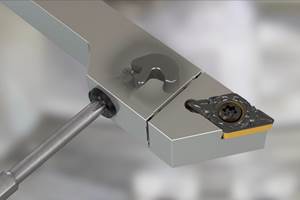Buying a Grinder: Latest Technological and Process Developments
Grinders have advanced in recent years with both technological and process improvements. Here is a rundown of some of those improvements.
Share






Whereas previous posts have discussed grinding machine construction, the abrasive process and various industries’ applications of grinding technology, this post looks at recent developments in grinding processes and machine designs.
In-Process Gaging for Closed-Loop Grinding
Closed- loop, in-process gaging is an option for measuring diameters and other features such as length during the machining cycle. For cylindrical grinding, electronic probes or gage heads may be mounted on the table, on slides or in the indexing turret to access the part being measured. In-process gaging of multiple diameters or dimensions can be accomplished using multiple gage heads or multiple slides, all using the same gage readout.
By using a precision ring gage of a known size, gage fingers can detect the precise workpiece diameter, then touch the top and bottom of the part diameter to feed results to the control system to command the machine to stop or to continue grinding until the exact diameter size is achieved.
For tool and cutting grinders, closed-loop gaging is quite remarkable because of the complicated geometry of most cutting tools. Grinding flutes and complex surfaces, such as the helixes on cutting tools that can vary widely by design, requires equally sophisticated, odd-shaped touch-probe styli to access the tool surface. Worn cutters can be easily restored by using the gage to instruct the machine when to retract during the regrinding cycle.
Machine Design Developments
Advancements in grinder design are producing high-precision, high-output, exceptionally fast grinders. The operation is becoming more automated, and the skill level of the experienced grinding operator is being embedded in the CNC control so that almost any machine operator can produce consistent, accurate parts.
Backlash-free, direct-drive linear motors are replacing ballscrews. Linear drives enable the machine to move exceptionally quickly, perform precise contouring and provide vibration damping in all in-feed axes, thus resulting in better grinding performance, better surface finish and greater precision.
Likewise, there is a move toward faster, integral spindle drive motors with high-frequency air bearings capable of running between 80,000 and 120,000 rpms while maintaining a constant torque curve throughout the speed range. Elsewhere in machine design, direct-drive motors are replacing drive belts to gain better machine control, higher speed and better precision.
Automatic Grinding Wheel Balancing
Auto-balancing of the grinding wheel while the spindle is running is another notable development. It uses a sensor that disperses weight to balance the wheel automatically to adjust for uneven distribution of wheel mass. Grinding wheels can sometimes become unbalanced because oil or coolant becomes trapped in portions of the wheel, whereas a balanced grinding wheel provides higher cutting rates, reduced cycle times and finer surface finishes.
Grinder CNCs
Control units on today’s grinders have more options and more automatic functions to assist the operator. For example, auto dressing with compensation enables the machine to go right back into the cut after dressing. CNC units with touchscreen capability and teach functions enable the operator to skip typing in data manually.
Related Content
Quick-Change Tool Heads Reduce Setup on Swiss-Type Turning Centers
This new quick-change tooling system enables shops to get more production from their Swiss turning centers through reduced tool setup time and matches the performance of a solid tool.
Read MoreOrthopedic Event Discusses Manufacturing Strategies
At the seminar, representatives from multiple companies discussed strategies for making orthopedic devices accurately and efficiently.
Read MoreHigh RPM Spindles: 5 Advantages for 5-axis CNC Machines
Explore five crucial ways equipping 5-axis CNC machines with Air Turbine Spindles® can achieve the speeds necessary to overcome manufacturing challenges.
Read MoreThe Future of High Feed Milling in Modern Manufacturing
Achieve higher metal removal rates and enhanced predictability with ISCAR’s advanced high-feed milling tools — optimized for today’s competitive global market.
Read MoreRead Next
Machine Shop MBA
Making Chips and 91±¬ÁĎÍř are teaming up for a new podcast series called Machine Shop MBA—designed to help manufacturers measure their success against the industry’s best. Through the lens of the 91±¬ÁĎÍř benchmarking program, the series explores the KPIs that set high-performing shops apart, from machine utilization and first-pass yield to employee engagement and revenue per employee.
Read MoreAMRs Are Moving Into Manufacturing: 4 Considerations for Implementation
AMRs can provide a flexible, easy-to-use automation platform so long as manufacturers choose a suitable task and prepare their facilities.
Read More



















